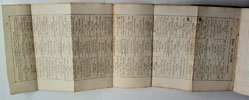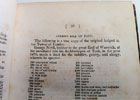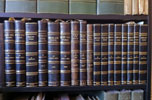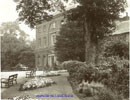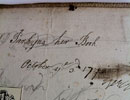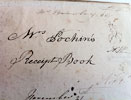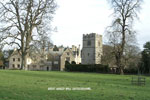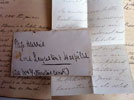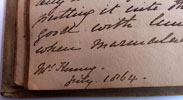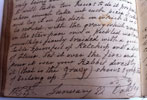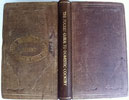Soyer.
Alexis Benoit
- A very rare signed first edition.
The Gastronomic Regenerator.
A SIMPLIFIED AND ENTIRELY NEW SYSTEM OF COOKERY, WITH NEARLY TWO THOUSAND PRACTICAL RECEIPTS SUITED TO THE INCOME OF ALL CLASSES. ILLUSTRATED WITH NUMEROUS ENGRAVINGS AND CORRECT AND MINUTE PLANS HOW KITCHENS OF EVERY SIZE, FORM THE KITCHEN OF A ROYAL PALACE TO THAT OF THE HUMBLE COTTAGE, ARE TO EB CONSTRUCTED AND FURNISHED. BY MONSIEUR A. SOYER, OF THE REFORM CLUB. LONDON: SIMPKIN, MARSHALL, & CO., STATIONERS' HALL COURT: AND SOLD BY JOHN OLLIVIER, PALL-MALL. 1846.
FIRST EDITION. 233x153x64mm. Front paste-down with the bookplate of Bannerman of Elsick – Crimonmogate (one of the oldest Scottish families from Buchan). 1 new fep . Signed on the original yellow end-paper, laid down and bound in: 'To Mrs S.G. Harding with the Auteur Compliments A. Soyer'. [1] Verso frontispiece portrait of the author drawn by his wife Emma Soyer and engraved in steel by H.B. Hall. Title page. [1] 1p Dedication to the Duke of Cambridge. [1] 1p Engraved plate. [1]2p List of Patrons. (1)viii Preface. (1)x-xii Description of the work. (1)xiv-xx Soyer’s new mode of carving. xxi-xxiv How everything should be in cooking. 1-720.3 [1] (1)2-18 Table of contents. (1)2-6 Madame Soyer including a self-portrait of Emma Soyer engraved in steel by H.B.Steel. In total there are 16 wood engraved plates. Also included, the Kitchen of the Reform Club, a table of a wealthy family, Soyer’s table at home. Folded plates of ‘Young Bavarians’ by Emma Soyer, a dinner for His Highness Ibrahim Pacha on blue paper and an engraving of the Reform Club's new kitchens. Fully bound in the original rose coloured cloth with fine blind tooling back and front. The spine has been very sympathetically re-laid. Gilt lettering on the front board and spine. There is a small 1” long ink stain. The frontis of Soyer and Emma Soyer plates are slightly foxed. Otherwise internally very clean. Overall a very good copy in the original state and with the rare signature.
-
In an online article Michael Garval, North Carolina State University writes perceptively of Alexis Soyer: --- Perhaps the most extraordinary thing about the extraordinary Alexis Soyer is that, while he too fashioned himself a man of letters, he would also transcend the constraints of this literary model and, far ahead of his time, prefigure the flamboyant personas of today's celebrity chefs. Soyer was born in France and raised there, first in Meaux-en-Brie, then in Paris. During the Revolution of 1830, he was working in the kitchen at the Foreign Office, it was attacked by angry insurgents. He ended up singing for his life: The cooks were driven from the palace, and in the flight two of Soyer's confrères were shot before his eyes, and he himself only escaped through his presence of mind, in beginning to sing 'la Marseillaise' et 'la Parisienne;' when he was in consequence carried off amid the cheers of the mob. (The memoirs of Volant and Warren - Soyer’s secretaries.) Soyer soon fled to England, where he would make his reputation, notably as Chef de Cuisine of London's prestigious Reform Club from 1837 to 1850. But his close call during the July Revolution remains an oddly revealing point of departure for his later, successful career. Casting him in the suggestive role of the faux-revolutionary, it already offers a glimpse at his general propensity for theatrics; his talent for rallying the public, and for making the most of unlikely opportunities; as well as his ambivalent class status and loyalty. A modestly-born opportunist, slaving away in service to the upper crust, and belting out Rouget de Lisle's or Casimir Delavigne's rabble-rousing lyrics at gunpoint, he appears at once a man of the people and lackey of the elite. Soyer was, in so many ways, a study in contradictions, "who drew the breath of his being from the French Romantics and who won the respect of Victorian England for his practical resourcefulness and powers of administration" (Helen Morris). He served refined food to the rich and powerful, and strained to ingratiate himself to them as well. But, amid the social and intellectual ferment over the problem of poverty, in the years surrounding the Revolution of 1848, he also put his skills to more humanitarian and egalitarian use. He toiled to feed Ireland's poor in the 1840s, or starving British soldiers in the Crimea a decade later, and published invaluable information to help the needy better feed themselves: first in a booklet, ‘The Poor Man's Regenerator’ (1847), from each copy of which he gave a penny to the poor; then more extensively in his ‘Shilling Cookery for the People’ (1854). A versatile, compassionate, and inventive cook, he was a prolific inventor as well—of bottled sauces and drinks, culinary gadgetry of all sorts, numerous innovations in the Reform Club's celebrated new kitchens, and many other things, including an excellent field stove, a variant of which, still called the Soyer stove, was used by the British army through the first Gulf War. Soyer was known for his exuberance, and eccentric style. A wit, prankster, raconteur, fine singer—and not just of revolutionary ballads—his first ambition was to be a comic actor, and for much of his life he frequented theatres and theatrical performers. A dapper Frenchman among drabber Victorians, he dressed as a Romantic dandy, in a style no longer the height of fashion at the height of his career in the 1840s and 50s—and did so even in the kitchen, eschewing the conventional chef's uniform. Beyond their rich embroidery, lavish silks, and extravagant colors, Soyer's clothes were characterized by their insistent cut on a bias, "à la zoug-zoug" in his own coinage, an idiosyncratic rendering of "zig-zag," the English phrase itself taking on the gallic flair of its inventor. Indeed, this predilection for diagonal lines was not limited to clothing designed and worn ‘studiously awry’, but rather part of a broader pattern. As biographer Helen Morris notes -- “Soyer's desire to be noticed, to be admired, above all to be extraordinary, grew ever more dominant. He tried not only to cook differently from everyone else, but to dress and talk and walk differently too. . . . he would not wear a single garment with either horizontal or perpendicular lines. His hats were specially built so that when clapped on at any angle they slanted in a coquettish way—in his own phrase, à la zoug-zoug. His coats had to be cut on the cross . . . . His visiting card . . . was not a rectangle but a parallelogram; so was his cigar-case, and even the handle of his cane slanted obliquely”.
To this list could be added many things: advertisements for Soyer's products, like these for his Sultana's Sauce, one with the central bottle tilted diagonally through the copy, the other with the copy inside a parallelogrammic field recalling the shape of his carte de visite; a whimsical dish created in honor of the ballerina Fanny Cerrito with whispy diagonals spiraling round a conical base, surmounted by a dancing figurine on pointe atop a thunderbolt-like stand composed of alternating angles; "a zig-zag passage," which Morris calls a "true Soyer touch" leading into the model soup kitchen that Soyer designed in Dublin; his fanciful menu for a "Grand Supper Lucullusien "a'la Zoug-Zoug" (Volant and Warren); and, as we shall see, numerous diagonal elements in the portraits of Soyer that accompany his published work. As such varied examples suggest, à la zoug-zoug might best be understood as the central trope in Soyer's creative imagination, and in his dandified public persona, emblematic of his drive to distinguish himself —both to achieve distinction, and to do so by being different.
• Soyer's position as chef of the Reform Club secured him some prominence but, in itself, does not explain the magnitude of his fame. His constant letters to various London papers, particularly the Times—touting his own accomplishments, promoting his latest schemes, weighing in on the questions of the day—helped keep him in the public eye. So too did the extensive marketing of his products, notably "Soyer's Sauce" as well as his several successful books on food and cookery. Combined with his flamboyant personal style, these forms of exposure made Soyer a favorite target of popular satire which, for better or worse, only increased his renown. He figured more often in the pages of Punch than many a Cabinet Minister.
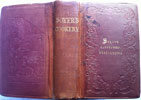

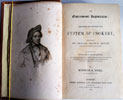
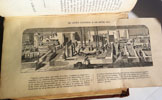

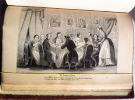
|
|

Antiquarian category
ref number:
11155
|









